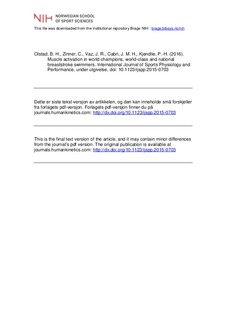| dc.contributor.author | Olstad, Bjørn Harald | |
| dc.contributor.author | Zinner, Christoph | |
| dc.contributor.author | Vaz, João Rocha | |
| dc.contributor.author | Cabri, Jan | |
| dc.contributor.author | Kjendlie, Per-Ludvik | |
| dc.date.accessioned | 2017-02-27T13:51:21Z | |
| dc.date.available | 2017-02-27T13:51:21Z | |
| dc.date.issued | 2016-08 | |
| dc.identifier.citation | International Journal of Sports Physiology and Performance. 2016, under utgivelse. doi: 10.1123/ijspp.2015-0703 | nb_NO |
| dc.identifier.uri | http://hdl.handle.net/11250/2432225 | |
| dc.description | I Brage finner du siste tekst-versjon av artikkelen, og den kan inneholde ubetydelige forskjeller fra forlagets pdf-versjon. Forlagets pdf-versjon finner du på journals.humankinetics.com / In Brage you'll find the final text version of the article, and it may contain insignificant differences from the journal's pdf version. The definitive version is available at journals.humankinetics.com | nb_NO |
| dc.description.abstract | Purpose: Investigating the muscle activation patterns and coactivation with the support of kinematics in some of the world’s best breaststrokers and identify performance discriminates related to national elites at maximal effort. Methods: Surface electromyography was collected in eight muscles from four world-class (including two world champions) and four national elite breaststroke swimmers during a 25 m of breaststroke at maximal effort. Results: World-class spent less time during the leg recovery (p = .043), began this phase with a smaller knee angle (154.6° vs 161.8°) and had a higher median velocity of 0.18 m/s during the leg glide compared to national elites. Compared to national elites, world-class swimmers showed a difference in the muscular activation patterns for all eight muscles. In leg propulsion phase; less triceps brachii activation (one swimmer 6% vs median 23.0% (8.8)). In leg glide phase; activation in rectus femoris and gastrocnemius during the beginning of this phase (all world-class vs only one national elite), a longer activation in pectoralis major (world champions 71% (0.5) vs 50.0 (4.3)) (propulsive phase of the arms). In leg recovery phase; more activation in biceps femoris (50.0% (15.0) vs 20.0% (14.0)), and a later and quicker activation in tibialis anterior (40.0% (7.8) vs 52.0% (6.0)). In the stroke cycle; no coactivation in tibialis anterior and gastrocnemius for world champions. Conclusion: These components are important performance discriminants. They can be used for improving muscular activation patterns and kinematics through the different breaststroke phases. Further, they can also be used as focus points for learning breaststroke to beginners. | nb_NO |
| dc.language.iso | eng | nb_NO |
| dc.publisher | Human Kinetics | nb_NO |
| dc.subject | swimming | nb_NO |
| dc.subject | electromyography | nb_NO |
| dc.subject | coactivation | nb_NO |
| dc.subject | motion analysis | nb_NO |
| dc.subject | performance | nb_NO |
| dc.title | Muscle activation in world champions, world-class and national breaststroke swimmers | nb_NO |
| dc.type | Journal article | nb_NO |
| dc.type | Peer reviewed | nb_NO |
| dc.subject.nsi | VDP::Samfunnsvitenskap: 200::Samfunnsvitenskapelige idrettsfag: 330::Andre idrettsfag: 339 | nb_NO |
| dc.source.journal | International Journal of Sports Physiology and Performance (IJSPP) | nb_NO |
| dc.identifier.doi | 10.1123/ijspp.2015-0703 | |
| dc.description.localcode | Seksjon for fysisk prestasjonsevne / Department of Physical Performance | nb_NO |
